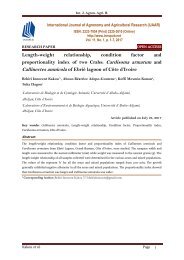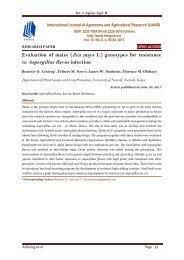Evaluation on drought and heat tolerance capacity of chickpea
Abstract Chickpea (Cicer arietinum L.) is one of the important legumes widely grown for dietary proteins in semi-arid Mediterranean climatic conditions. To evaluate the genetic diversity with improved heat and drought tolerance capacity in chickpea, thirty-four selected chickpea genotypes were tested under different field-growing conditions (rain fed winter sowing, irrigated-late sowing and rain fed-late sowing) in 2015 and 2016 growing seasons. A factorial experiment in randomized complete block design with 3 reps was conducted at the Eastern Mediterranean Research Institute Adana, Turkey. Based on grain yields under different growing conditions, the values of tolerance index, mean productivity, yield index, yield stability index, stress tolerance index, stress susceptibility index, and geometric mean productivity were calculated to identify economically higher-yielding chickpea genotypes with greater heat and drought tolerance capacity. There were highly significant differences observed among the tested chickpea genotypes response to drought and heat stresses. Besides, in both non-stress and stress conditions mean productivity, yield index, stress tolerance index, and geometric mean productivity, which highly positively significantly correlated with seed yields, were the best indices. Among the chickpea genotypes, the Aksu, Arda, Çakır, F4 09 (X 05 TH 21-16189), FLIP 03-108 were identified with a higher drought and heat tolerance capacity. Based on our field studies, it is suggested that the drought and heat tolerance indicators of plants can be used by breeders to select stress-resistant economically productive chickpea genotypes suitable to grow under Mediterranean climatic conditions.
Abstract
Chickpea (Cicer arietinum L.) is one of the important legumes widely grown for dietary proteins in semi-arid Mediterranean climatic conditions. To evaluate the genetic diversity with improved heat and drought tolerance capacity in chickpea, thirty-four selected chickpea genotypes were tested under different field-growing conditions (rain fed winter sowing, irrigated-late sowing and rain fed-late sowing) in 2015 and 2016 growing seasons. A factorial experiment in randomized complete block design with 3 reps was conducted at the Eastern
Mediterranean Research Institute Adana, Turkey. Based on grain yields under different growing conditions, the values of tolerance index, mean productivity, yield index, yield stability index, stress tolerance index, stress susceptibility index, and geometric mean productivity were calculated to identify economically higher-yielding chickpea genotypes with greater heat and drought tolerance capacity. There were highly significant differences observed among the tested chickpea genotypes response to drought and heat stresses. Besides, in both non-stress and stress conditions mean productivity, yield index, stress tolerance index, and geometric mean productivity, which highly positively significantly correlated with seed yields, were the best indices. Among the chickpea genotypes, the Aksu, Arda, Çakır, F4 09 (X 05 TH 21-16189), FLIP 03-108 were identified with a higher drought and heat tolerance capacity. Based on our field studies, it is suggested that the drought and heat tolerance indicators of plants can be used by breeders to select stress-resistant economically productive chickpea genotypes suitable to grow under Mediterranean climatic conditions.
Create successful ePaper yourself
Turn your PDF publications into a flip-book with our unique Google optimized e-Paper software.
Int. J. Agr<strong>on</strong>. Agri. R.<br />
Deshmukh DV, Mhase LB, Jamadagni BM.<br />
2004. Performance <strong>of</strong> Desi <strong>and</strong> Kabuli Chickpea<br />
Genotypes under Irrigated <strong>and</strong> Rainfed C<strong>on</strong>diti<strong>on</strong>s.<br />
Indian J. Pulses Res. 17(2), 181-182.<br />
Farshadfar E, Jamshidi1 B, Aghaee M. 2012.<br />
Biplot analysis <strong>of</strong> <strong>drought</strong> <strong>tolerance</strong> indicators in<br />
bread w<strong>heat</strong> l<strong>and</strong>races <strong>of</strong> Iran. Intl J Agri Crop Sci<br />
4(5), 226-233.<br />
Fern<strong>and</strong>ez, GCJ. 1992. Effective selecti<strong>on</strong> criteria<br />
for assessing plant stress <strong>tolerance</strong>. Proceedings <strong>of</strong><br />
the internati<strong>on</strong>al Symposium <strong>on</strong> Adaptati<strong>on</strong> <strong>of</strong><br />
Vegetable <strong>and</strong> Other Food Crops in Temperature <strong>and</strong><br />
Water Stress 257-270.<br />
Fischer RA, Maurer R. 1978. Drought Resistance in<br />
Spring W<strong>heat</strong> Cultivars. Aust. J. Agric. Res 29, 897-912.<br />
Ganjeali A, Kafi M, Bagheriv F, Shahriyari F.<br />
2005. Screening for <strong>drought</strong> <strong>tolerance</strong> <strong>on</strong> Chickpea<br />
genotypes. Iran J Field Crops Res 3, 122-127.<br />
Ganjeali A, Porsa H, Bagheri A. 2011.<br />
Assessment <strong>of</strong> Iranian <strong>chickpea</strong> (Cicer arietinum L.)<br />
germplasms for <strong>drought</strong> <strong>tolerance</strong>. Agr Water Manage<br />
98, 1477-1484.<br />
Gavuzzi P, Rizza F, Palumbo M, Campaline RG,<br />
Ricciardi GL, Borghi B. 1997. <str<strong>on</strong>g>Evaluati<strong>on</strong></str<strong>on</strong>g> <strong>of</strong> field <strong>and</strong><br />
laboratory predictors <strong>of</strong> <strong>drought</strong> <strong>and</strong> <strong>heat</strong> <strong>tolerance</strong> in<br />
winter cereals. Can. J. Plant Sci 77, 523-531.<br />
Golabadi M, Arzani A, Mirmohammadi<br />
Maibodi SAM. 2006. Assessment <strong>of</strong> <strong>drought</strong><br />
<strong>tolerance</strong> in segregating populati<strong>on</strong>s in durum w<strong>heat</strong>.<br />
Afr J Agric Res 1, 162-171.<br />
Lin CS, Binns MR, Lefkovitch LP. 1986. Stability<br />
analysis: where do we st<strong>and</strong>. Crop Sci 26, 894-900.<br />
Moein R, Akbar S, Shahram N, Alireza Z. 2015.<br />
Screening Drought Tolerant Genotypes in Chickpea<br />
using Tolerance Score Method. Int. J <strong>of</strong> Advanced<br />
Biological Research 3.<br />
Naderi R, Emam Y. 2014. <str<strong>on</strong>g>Evaluati<strong>on</strong></str<strong>on</strong>g> <strong>of</strong> rapeseed<br />
(Brassica napus L.) cultivars performance under<br />
<strong>drought</strong> stress. AJCS 8(9), 1319-1323.<br />
Pireivatlou AS, Masjedlou BD, Aliyev RT. 2010.<br />
<str<strong>on</strong>g>Evaluati<strong>on</strong></str<strong>on</strong>g> <strong>of</strong> yield potential <strong>and</strong> stress adaptive trait<br />
in w<strong>heat</strong> genotypes under post an thesis <strong>drought</strong><br />
stress c<strong>on</strong>diti<strong>on</strong>s, Afric J <strong>of</strong> Agric Res 5, 2829-2836.<br />
Rajaram S, Braun HJ, Ginkel MV. 1996.<br />
CIMMYT’s approach to breed for <strong>drought</strong> <strong>tolerance</strong>.<br />
Euphytica 92, 147-153.<br />
Rajaram S, Van Ginkle M. 2001. Mexico, 50 years<br />
<strong>of</strong> internati<strong>on</strong>al w<strong>heat</strong> breeding. In: B<strong>on</strong>jean, A.P.,<br />
Angus, WJ. (Eds.), The World W<strong>heat</strong> Book: A History<br />
<strong>of</strong> W<strong>heat</strong> Breeding. Lavoisier Publishing, Paris,<br />
France pp. 579-604.<br />
Rathjen AJ. 1994. The biological basis <strong>of</strong> genotype -<br />
envir<strong>on</strong>ment interacti<strong>on</strong>: its definiti<strong>on</strong> <strong>and</strong><br />
management. In: Proceedings <strong>of</strong> the Seventh<br />
Assembly <strong>of</strong> the W<strong>heat</strong> Breeding Society <strong>of</strong> Australia,<br />
Adelaide, Australia.<br />
Rosielle AA, Hamblin J. 1981. Theoretical Aspects<br />
<strong>of</strong> Selecti<strong>on</strong> for Yield in Stress <strong>and</strong> N<strong>on</strong>- stress<br />
Envir<strong>on</strong>ment Crop Sci 21, 943-946.<br />
Singh KB. 1993. Problems <strong>and</strong> Prospects <strong>of</strong> Stress<br />
Resistance Breeding in Chickpea. Editör: Singh, K.B.,<br />
Saxena, M.C. p. 17-35.<br />
Sio-Se Mardeh A, Ahmadi A, Poustini K,<br />
Mohammadi V. 2006. <str<strong>on</strong>g>Evaluati<strong>on</strong></str<strong>on</strong>g> <strong>of</strong> <strong>drought</strong><br />
resistance indices under various envir<strong>on</strong>mental<br />
c<strong>on</strong>diti<strong>on</strong>s. Field Crops Research 98, 222-229.<br />
Wery J, Turc O, Lecoeur J. 1993. Mechanism <strong>of</strong><br />
Resistance to Cold, Heat <strong>and</strong> Drought in Cool-Seas<strong>on</strong><br />
Legumes, with Special Reference to Chickpea <strong>and</strong><br />
Pea. In ‘Food Legumes’. (Eds: Singh, KB., MC.,<br />
Saxena) Wiley Publishing, Chichester, UK 271-291.<br />
Yücel D, Mart D. 2014. Drought Tolerance in<br />
<strong>chickpea</strong> Genotypes. Turkish J <strong>of</strong> Agriculture <strong>and</strong><br />
Natural Sci 1, 1299-1303.<br />
Zebarjadi AR, Chaghakaboodi Z, Kahrizi D.<br />
2011. <str<strong>on</strong>g>Evaluati<strong>on</strong></str<strong>on</strong>g> <strong>of</strong> Rapeseed Genotypes (Brassica<br />
napus L.) under Drought Stress C<strong>on</strong>diti<strong>on</strong>s.<br />
Researches <strong>of</strong> the First Internati<strong>on</strong>al C<strong>on</strong>ference.<br />
Babyl<strong>on</strong> <strong>and</strong> Razı Uni.<br />
Yücel et al. Page 117





